In building The McLuhan Institute, my biggest challenge perhaps has been the sheer scope of the project. McLuhan work is so vast, touching so many areas. How do I explain it to anyone? How do I preserve it? More importantly, how do I take it forward?
If it were simply a collection of books and papers, setting up a McLuhan museum (it’s a little crazy that there is no McLuhan museum), that would be one thing.
If it were simply a matter of setting up a dedicated place to study and teach McLuhan work (there isn’t one), that would be one thing.
If it were simply a matter of setting up somewhere that would continue the work that Marshall McLuhan began, that Eric McLuhan kept alive (there isn’t one), that would be one thing.
If it were only setting up a place to facilitate the artistic exploration of the personal and social consequences of technologies, a place to carry on McLuhan work in the McLuhan tradition… if it were only one or even two of these things, it would be fairly straightforward.
A McLuhan Institute needs to be all of these things.
I started thinking about a structure back in 2017. I thought of it as an umbrella under which to carry out a range of activities. My father, Eric McLuhan, had worked with his father, Marshall McLuhan, since the mid-1960s. Together they did some very important work (notably, discovering the ‘laws of media’ (‘Laws of Media: The New Science’ 1988). Their close collaboration ended when Marshall died suddenly on New Year’s Eve 1980, and my dad kept on going in his own way.
I had been getting increasingly involved in the work for almost a decade, and I became aware of my father’s mortality, and I got scared. I didn’t want to be left in the position my father was, with no plan to continue the work, with few resources.
The Centre for Culture and Technology, which Marshall founded, was closed even before he died (it reopened eventually, but to say the least, has never been the same… could never be the same). My father, despite his credentials (having not only worked intimately with his father, but also earned his Ba, Ma, and Ph.D) found it impossible to continue the work inside academia – if you thought that a University would welcome McLuhan work, you’d be very wrong.
The message was, to me, very clear: it was time to do things differently.
As it happened, my father died within that year. But I had already put a lot of thought into it, and talked it over with dad. I think he realized that just as he had to do things his way, for his time, so I needed to do things my way, for my time.
I could go on, (I have and will again) but I was just trying to set the scene for this short video I am quite proud to present.
This ‘newsletter’ launched earlier this year with a serialization of a piece I did called ‘Maelstrom Escape Strategies.’ (Here’s part one.) That work was made possible by Reggie James, visionary co-founder of Eternal. In my work trying to take The McLuhan Institute (TMI) from an idea to an institution, I’ve had several roadblocks (like not being able to register the name thanks to the government insisting I can’t use the word ‘institute’) but I’ve had way more help. People like Reggie who saw what I was doing and wanted to help. Some have joined my Patreon page. Some threw in a few bucks to help me try to register ‘The McLuhan Institute’ (I had to abandon that when it seemed I needed bigger guns to persuade the Ontario Ministry of Colleges and Universities that I should be allowed to create a McLuhan institute). Some have subscribed to this newsletter, and some, like Reggie have gone above and beyond.
Reggie did me one better and connected me with some people at Zora. Zora is… well, “Zora is the best place to mint,” is how they would finish that sentence. When I told Brendan that ‘the best place to mint’ would not help my people very much (not me, I obviously completely understand what this all means….srsly….) he replied:
“ZORA exists to provide tools for creativity to be discovered, distributed, and collected on the blockchain.
I have to admit that when I started talking with Brendan, Jacob, and others at ZORA, actually when I started talking to Reggie even, I had no real idea what blockchain was about. ‘Distributed ledger’ wasn’t much more helpful. Start talking about crypto and nfts and eyes will either roll, glaze over, or shift back and forth…shiftily.
Perhaps what blockchain is, is an umbrella.
For me, it may be a means of achieving several objectives I have and which I am building The McLuhan Institute for, namely, archiving and preserving materials, and making them accessible for all the people who can’t physically come here (near Wellington/Bloomfield, Ontario, Canada) and can’t easily mentally grasp them either.
A way of preserving history, building community, and exploring the present.
Well. ZORA sent up a couple of guys (Josh and Dimitri? Forgive me fellas, new names often escape me!) who showed up looking like they just left New York City, which they had. They spent much of the day here chatting with me, following me around as I explained what I was up to. And they’ve managed to distill it down to just under ten minutes of video, which you can now access online, onchain.
So the interesting thing about ‘minting onchain’ is that it can be a mutually beneficial transaction. Let me back up a second. The way I understand it is that ‘minting’ something essentially saves it or a copy of it for you. In art terms, it’s like going to a gallery to look at a painting. Anyone can look at it. If you want a copy to take home, you can get one at the gif(t) shop. Sure, you can just snap a photo of it with your phone or whatnot, but it isn’t the same as having your own copy, is it? It’s also, kind of, stealing. So people will ‘mint’ something not just to have a copy, but often more to support the project or artist. Because stealing from friends is unfriendly.
The cost to mint something depends on two factors. The price attached to the work and the ‘gas’ fee.
In the case of my video with Zora, there’s no sticker price. There is a ‘gas’ price or service charge. I think about that in terms of making a photocopy at my local print shop. A nice colour copy is going to cost me $1. To print it at home I need a printer and ink.
Another way they talk about it is in terms of ‘bookmarking.’ The internet is massive. Minting essentially saves your place so you can find it again without having to search far and wide. In book terms, when I find a piece I want to be able to refer to again, I index it in the back of the book. I make a note of the page so when I want to find it, I just flip to the back, see the note and page number, and there it is. You might even say, it makes it easier to retrieve, and that in the McLuhan sense, it ‘retrieves,’ or brings back in a new form, the book index.
I sure hope I have all of this right.
This way of doing things (‘onchain’) obviously enhances or amplifies many things, as it also obsolesces or takes over from several current ways of doing things, and it is worth considering what may happen to the form when it is pushed to and beyond its limits.
There are also very many potential uses for what I am trying to do with The McLuhan Institute, and I am very much looking forward to exploring them.
Here is the text I wrote to accompany the video:
A friend of mine (shoutout Reggie) has a company (Eternal) where they’re big on “empowering artists.” This resonates with me deeply.
The McLuhan Galaxy is vast, it contains multitudes. Marshall McLuhan’s interests in engineering and in poetry and literature curiously led him toward interest in the structure of culture and technology, particularly the nature and effects of human innovation as it reshapes humans and cultures individually and socially.
“We begin with effects and work back to causes.” This is the method of the detective in fiction since Poe at least, and it is a primary McLuhan method as well.
As founder and director of The McLuhan Institute (est. 2017), and inheritor of not only a rich and singular intellectual and investigatory tradition but of a vast and eclectic archive of artifacts, part of my job is custodial. But I am not interested in monuments or museums for the simple sake of preservation – I am interested, and it is my voluntary duty and privilege, in preserving the past in service of the present and future. The work Marshall McLuhan began, which Eric McLuhan continued, is useful to us today as we struggle to make sense of the world around us, to take some control over our lives as they are increasingly mediated and shaped by our technologies, these extensions of ourselves.
In that case, the work is not only useful, it’s vital, and probably deserves more attention and support.
As Pound said in ‘ABC of Reading,’ “the artist is the antennae of the race.” Out there on the frontier of sensation, ahead of the rest of us whose senses atrophy as they age, they first experience the effects of new technologies, they attempt to express them for the rest of us. This art is not for decoration or aesthetic enjoyment – that is merely the literal level. This art is giving us a taste of what we’re in for.
Bringing together Poe, Pound, and McLuhan, we have an opportunity to get ahead of the seemingly inevitable chain of ‘efficient causality’, of effects proceeding helplessly from causes, – to anticipate effects and make different design choices to avoid or at least mitigate them. This brings us into the world of ‘media ecology,’ where we’re not content to pollute our environment and suffer the consequences in our ignorance.
A large part of this opportunity consists in empowering artists, these canaries in our techno-environmental coalmine. Part of my job, as I see it, is to facilitate the creation of new works of art that might help us make sense of what’s going on, and make different choices going forward. This is the basis of the arts program I’m building here at The McLuhan Institute.
I’m really grateful to all the people who have pitched in to help get The McLuhan Institute this far. As we descend ever deeper into the technological vortex, it’s easy to give in to fear, to despair. But all around us, if we take a deep breath and look, there are signs of life and lift. Together, we can change, we are changing, the way we do things.
Things are looking up.

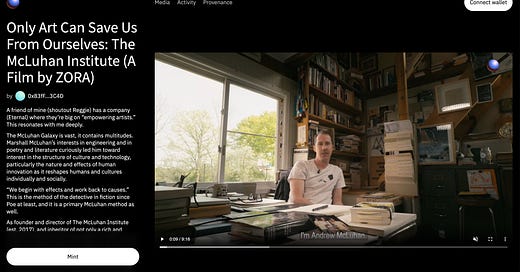




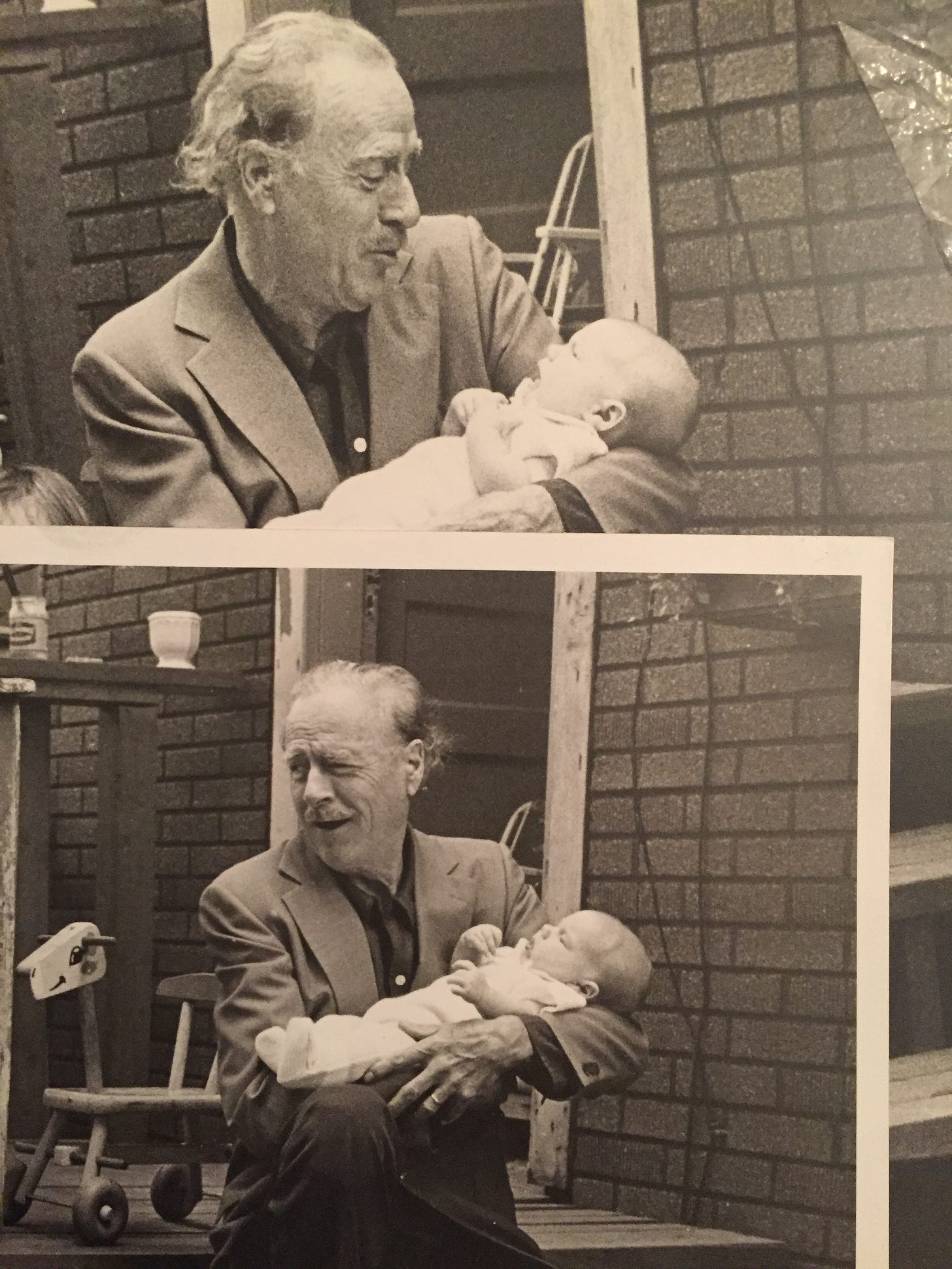
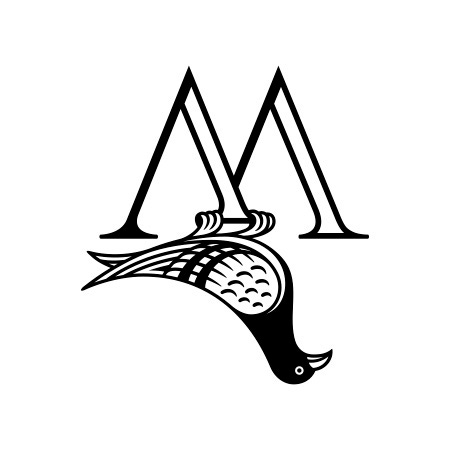
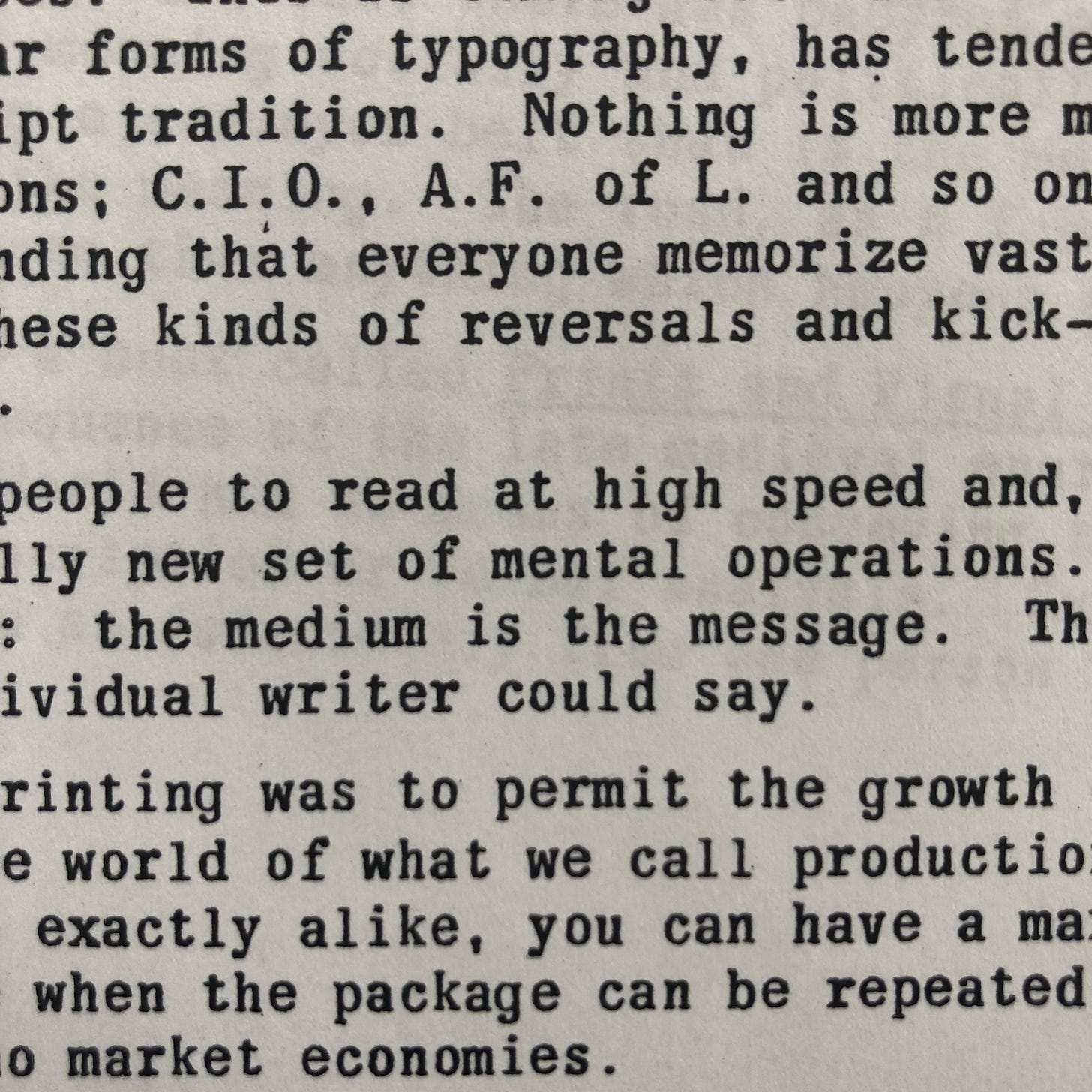

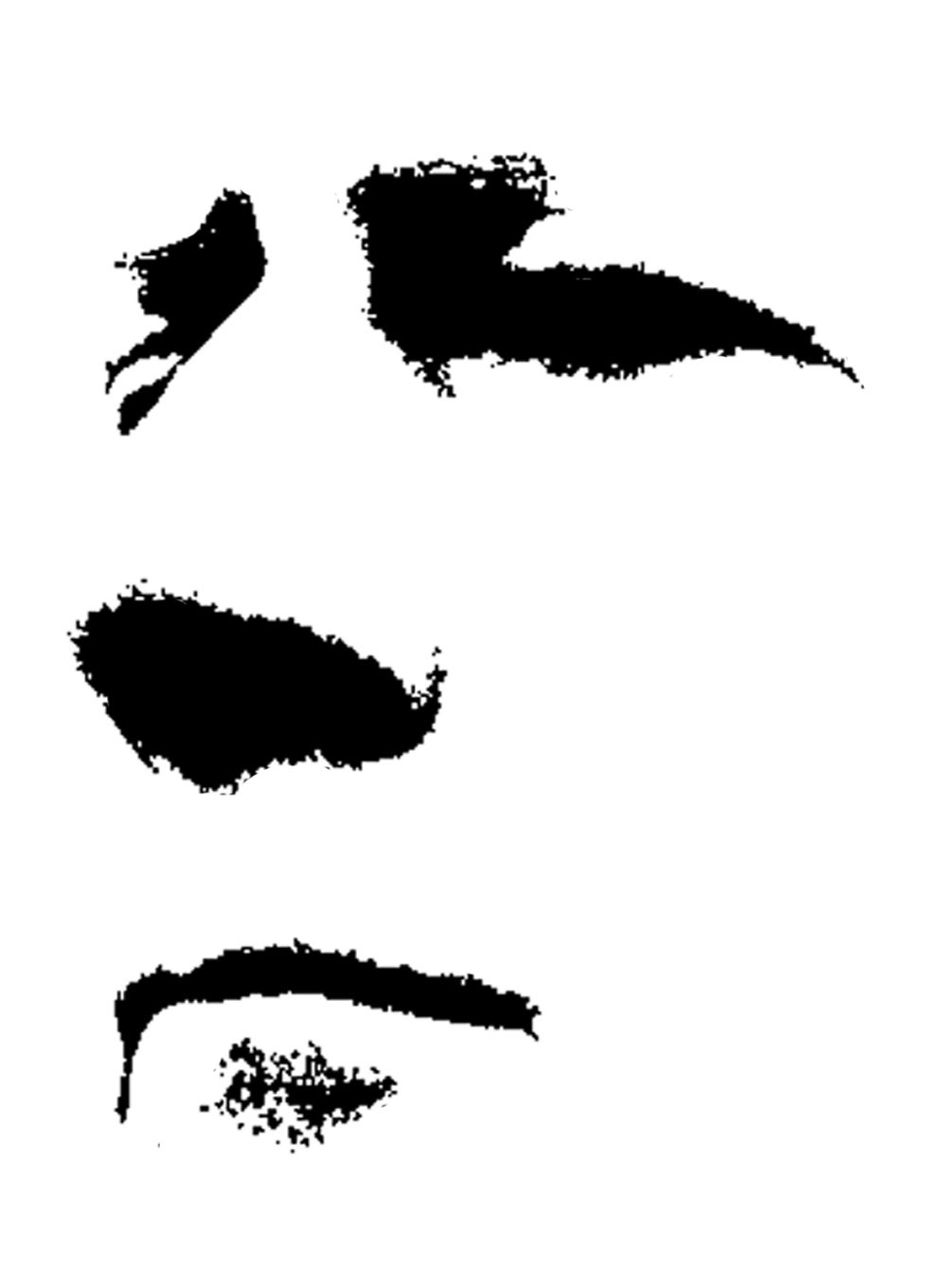
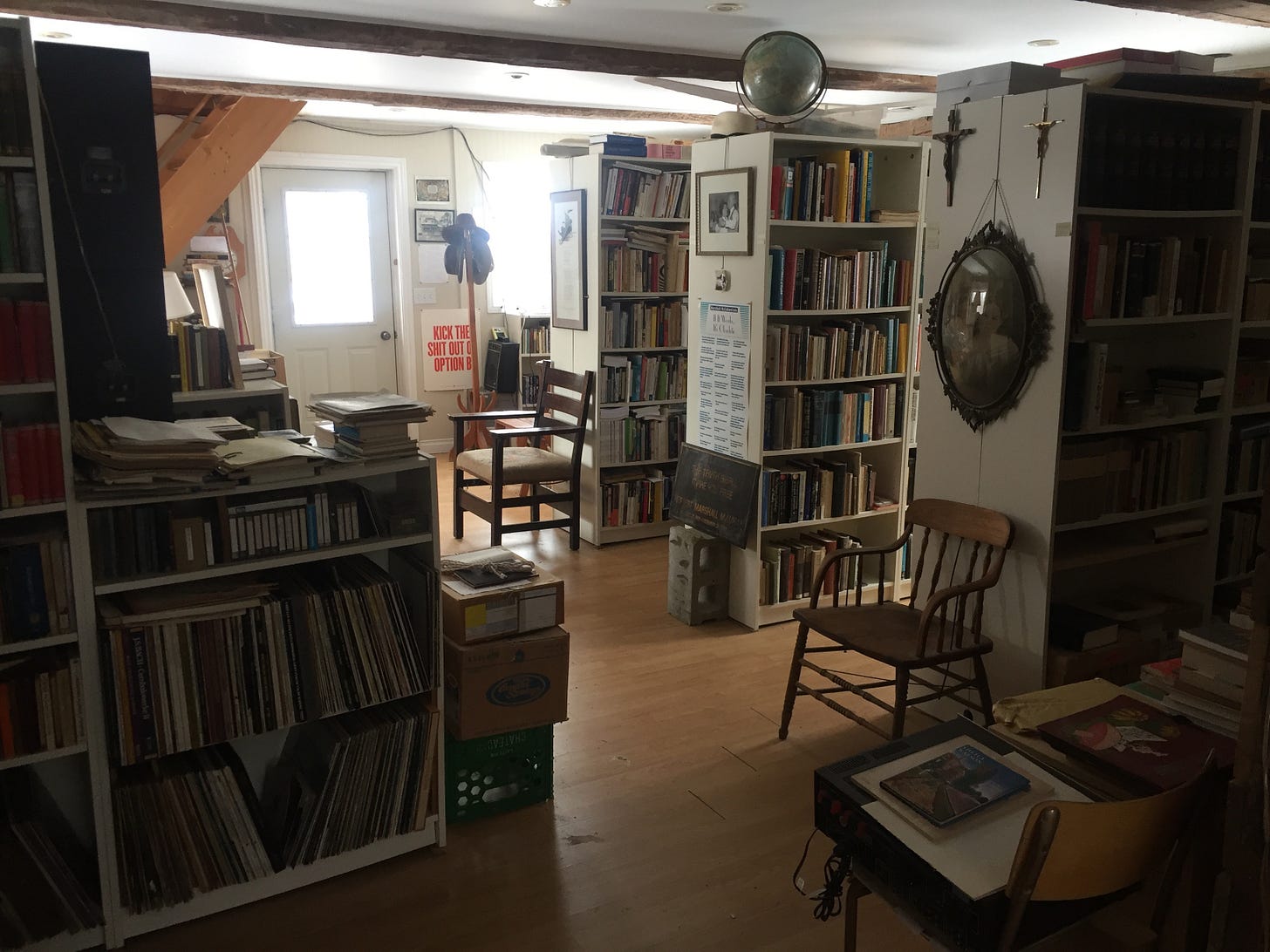
Inspiring! The mission of the McLuhan Institute is inspiring. The video is substantial, nice and fun. Nice work.
Probe : “BLAST the blockchain” 💥